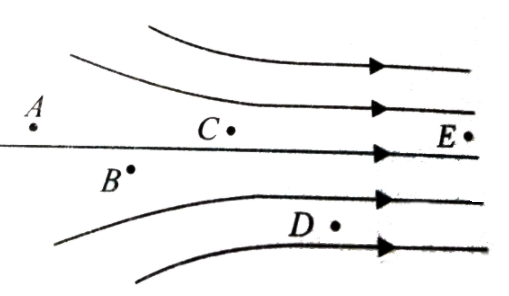
A non-uniform electric field is represented by the diagram.At which of the following points , the electric field is greatest in magnitude.

1. A
2. B
3. C
4. D
5. E

Answer
436.2k+ views
Hint:
- The magnitude of electric fields depends on how close the electric lines are.
- In fig, we see two types of electric field lines, uniform and non-uniform.
Complete step by step solution:
In the figure, we can see there are two sets of region
a. The first region, where the field lines are non-uniform.
b. The second region, where the field lines are uniform.
Now, if we observe,
- In the first or non-uniform region, points \[A,B,C\] reside, whereas point D resides in the second or uniform region.
- So the closest distance between the electric field lines is observed at point D.
But In the case of point A, the field lines distance is higher compare to the other points \[\left( {point{\text{ }}B,{\text{ }}C,{\text{ }}D} \right).\] So the magnitude of the electric field at point A is minimum.
- If we consider point B, we will discern that the distance between the field lines is lesser than the length at point A whereas higher than at point C and D. So the magnitude at point B will be higher than at point A but lesser than at point C and D.
- Similarly, the distance between the electric field lines at point C is lesser than at point A, B, and higher than at point D.
- Consequently, at point C, we will witness the higher magnitude than the magnitude at point A, B but lesser than at point D.
- But at point D, the distance between the electric field lines is minimum resulting in the maximum magnitude of the Electric field.
So the correct answer is option 4. D
Note:
a. The electric field lines' direction is always from positive to negative charge.
b. The magnitude of the electric field is proportional to the magnitude of the charge.
c. The number of electric field lines is proportional to the magnitude of the charge.
- The magnitude of electric fields depends on how close the electric lines are.
- In fig, we see two types of electric field lines, uniform and non-uniform.
Complete step by step solution:
In the figure, we can see there are two sets of region
a. The first region, where the field lines are non-uniform.
b. The second region, where the field lines are uniform.
Now, if we observe,
- In the first or non-uniform region, points \[A,B,C\] reside, whereas point D resides in the second or uniform region.
- So the closest distance between the electric field lines is observed at point D.
But In the case of point A, the field lines distance is higher compare to the other points \[\left( {point{\text{ }}B,{\text{ }}C,{\text{ }}D} \right).\] So the magnitude of the electric field at point A is minimum.
- If we consider point B, we will discern that the distance between the field lines is lesser than the length at point A whereas higher than at point C and D. So the magnitude at point B will be higher than at point A but lesser than at point C and D.
- Similarly, the distance between the electric field lines at point C is lesser than at point A, B, and higher than at point D.
- Consequently, at point C, we will witness the higher magnitude than the magnitude at point A, B but lesser than at point D.
- But at point D, the distance between the electric field lines is minimum resulting in the maximum magnitude of the Electric field.
So the correct answer is option 4. D
Note:
a. The electric field lines' direction is always from positive to negative charge.
b. The magnitude of the electric field is proportional to the magnitude of the charge.
c. The number of electric field lines is proportional to the magnitude of the charge.
Recently Updated Pages
Glucose when reduced with HI and red Phosphorus gives class 11 chemistry CBSE

The highest possible oxidation states of Uranium and class 11 chemistry CBSE

Find the value of x if the mode of the following data class 11 maths CBSE

Which of the following can be used in the Friedel Crafts class 11 chemistry CBSE

A sphere of mass 40 kg is attracted by a second sphere class 11 physics CBSE

Statement I Reactivity of aluminium decreases when class 11 chemistry CBSE

Trending doubts
10 examples of friction in our daily life

One Metric ton is equal to kg A 10000 B 1000 C 100 class 11 physics CBSE

Difference Between Prokaryotic Cells and Eukaryotic Cells

State and prove Bernoullis theorem class 11 physics CBSE

What organs are located on the left side of your body class 11 biology CBSE

How many valence electrons does nitrogen have class 11 chemistry CBSE




